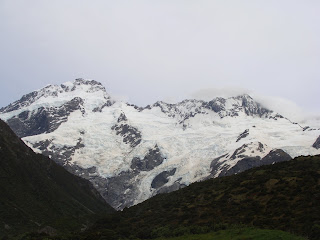I am lucky in that my sister lives in New Zealand and I get to visit her every 4 or 5 years. She lives in the South Island, on the Pacific coast in Dunedin, but we always go away to the mountains when I’m there, a holiday within a holiday, if you like! My last visit was Christmas 2009, midsummer in the southern hemisphere… hot sunny weather, and exactly what I needed after the disastrous year 2009 turned out to be.
Early morning in The Aoraki/Mount Cook National Park, 25 December 2009
Dunedin is famous for the only mainland albatross breeding colony situated at the far end of the Otago Peninsula, some 30 minutes drive from the city. These awesome birds are endangered thanks to longline tuna fishing, amongst other things, and the Royal Albatross Colony is working hard to protect and preserve the species. Royal Albatrosses have a wingspan of up to 6 feet, and to watch them soar over the seacliffs at Taiaroa Head is a very special feeling indeed. Their chicks are the size of turkeys, and are all fluffy… cute in an ugly kind of way, but when you see what they mature into, it takes your breath away. Albatrosses glide, using thermals and wind currents to keep them aloft, they don’t flap their huge wings. They can, and do, spend months out at sea, only coming to land to breed. I felt privileged to watch these magnificent birds in the sky, seeing their clumsy landings and feeding their young.
Royal Albatrosses, Dunedin, New Zealand
View from the campsite, Lake Middleton, New Zealand
The Aoraki/Mount Cook National Park is a harsh land of ice and rock, even at the height of summer. Glaciers cover 40% of it. There are 19 peaks over 3,000 metres, including Mount Cook, the highest peak in New Zealand at 3754 metres. [I think this is the highest mountain I’ve ever seen, but Everest is 8850m… over twice the height!]
“The glaciers that have helped shape the park's landscape include five major valley systems: Godley, Murchison, Tasman, Hooker and Mueller. The Tasman Glacier, New Zealand's largest and longest glacier, is clearly visible from the main highway at the entrance of the park”We came here on Christmas morning to walk up to the foot of the Hooker Glacier, a 4-hour round hike. I saw my first avalanche while still in the car park, but as there was one every 3 or 4 minutes, the novelty soon wore off. I could see the huge cracks in the snow as the sun’s warmth destabilised the previous winter’s fall. The walk itself took us across the Hooker River, a fast glacial run-off flow rendered opaque by the quantities of rock dust carried within the water, and along the side of the valley where the glacier has retreated.
Crossing the Hooker River, it was very windy!
I was hoping to see some Keas, alpine parrots unique to New Zealand and famous for their cheeky antics, however, they had moved further up the slopes to avoid the summer heat. So I made do with admiring the ice-bergs in the moraine-dammed lake at the foot of the Hooker Glacier… they were very blue, and while not Antarctic sized, I was suitably impressed – this was ice, 1000’s of years old yet melting in the summer sun as part of the glacial retreat caused by rising temperatures planet-wide.
A long and lonely road...
I have been to New Zealand 5 times now, and never tire of visiting. The South Island is so very beautiful, with awe-inspiring scenery, dense temperate rain forest, and unique wildlife. It is sad that so many of the native creatures are in decline, mainly due to the interference of humans who brought cats, dogs, rats, stoats, rabbits and all kinds of other animals from ‘home’. These animals are now destroying the unique bird population, many of which are flightless. The Kakapo, a flightless parrot, last seen on TV with Stephen Fry and Mark Carwardine, is critically endangered and can only be found on a protected small island off the main NZ coast. The Kiwi, the national emblem, is also under pressure, with introduced small mammals feeding on their eggs. I find it shocking that these islands maintained a rich and thriving ecosystem for millennia, yet since the arrival of the first humans, some 600 years ago, began a destructive process that is getting harder each year to counteract.
Enjoying the summer sunshine - December 2009
But it is difficult to think of the destruction of species and habitats when you are watching a Kahu (Australasian Harrier) wheel above the plains, circling around and then diving at some poor possum or rabbit in the distance. When the sun sets behind a range of snow-capped mountains, casting fiery streaks across the sky to reflect in the lakes below, I feel insignificant in comparison to the natural beauty all around me. Amazing landscapes, such as those in New Zealand, engender a feeling of peace within me, yet help me put my own issues and problems into perspective.
How to spend Christmas 2009
As much as I love my books, and the worlds I inhabit within their pages, nothing compares to the feeling I get when surrounded by the power of nature. Whether it is the Irish Atlantic coast, with giant waves crashing against the cliffs, or India with it's deep red soil and white sandy beaches, or New Zealand in the clean mountain air, I will always have a deep respect for the beautyand richness our planet offers us. I only wish others felt the same way, instead of destroying our natural resources in the pursuit of profit.
Sunset over Lake Ohau
Credit: All photos were taken by my sister, Bronagh Quinn. I wonder has she read this yet?!








Yep, read it and thanks for the credit.
ReplyDeleteMaybe it should have been titled "book geek goes bush" And where is the campaign for save the sandfly?
Bro xx